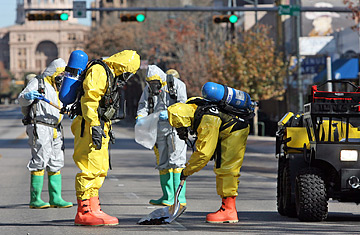
Safety crews pick up dead birds on Congress Ave. in Austin, Texas, January 8, 2007.
While bird lovers admire grackles for their iridescent feathers and canny ability to mimic human voices, for others they're a nuisance — dirty, noisy and a plague that has prompted cities and institutions across the country to declare war on the black clouds that roost in trees throughout the southern U.S. So when the black birds turned up dead, suspicions about a possible culprit exposed divisions that run deep across the country between the pro- and anti-grackle camps.
On the morning on Jan. 8, three Austin policemen on patrol downtown found the dead birds feet up on Congress Avenue, the city's busy main boulevard. With ever-present concerns about bird flu and terrorism, HAZMAT teams, the fire and police departments, the county health department, the U.S. Department of Agriculture, the Texas National Guard's rapid response team and even the FBI were quickly on scene as the city closed off downtown.
Common grackles, as they are known, are just that — common, especially in the fall and winter when southern birds move into the urban areas and northern birds fly south in great flocks of thousands. Google "grackle" and you will find birding sites that describe them as "opportunistic foragers" and "boisterous and abundant." For every rhapsodic bird lover, there is someone like director Michael Berry, whose successful short film Day of the Grackle, depicts one man's war with a grackle from hell.
The Great Austin Grackle Kill of '07 had all sides engaged. Had the birds, which number in the thousands in downtown Austin, been poisoned by some angry loft developer? Or had they died from a bout of overindulgence of mistletoe during the holidays? The answer to both is no, according to experts at Texas A&M University. They say the grackles fell prey to parasites and a sudden dip in temperatures, struck down by a double whammy of bad luck in the bird world.
"Most wild birds have some parasites, but these birds were overwhelmed," said Lev G. Gayle, executive director of A&M's veterinary diagnostic lab. Autopsies revealed that the birds had parasites in every organ in their body, even in skeletal muscle and their brains, in a few cases. All wild birds have some level of parasites in their bodies, Gayle said. It was likely these 60, which appeared not to have eaten recently, were the most vulnerable and weakened of a large flock numbering in the hundreds. Increasing parasite levels made them weaker and more susceptible to sudden temperature change.
Learning the details of the daily life of the grackle may not be essential for all of us, but Gayle suggests that we do keep a close eye on the skies. Years ago, grackles were used as sentinels in coal mines, Gayle said, and with today's terror and health threats they still serve as an early warning system. Hence the Congress Avenue shutdown was, in Gayle's opinion, appropriate. A more geographically widespread grackle kill in the city might have indicated a potential avian influenza outbreak, Gayle said.
Given bird flu fears and pure aesthetics, no one wants to see flocks of shiny black birds stiff on the sidewalk. But weakened birds will continue to die when temperatures dip and, if they land on a busy downtown boulevard, even in a city like Austin where bird lovers abound, they will spark yet another debate in the war on grackles that is being waged across the country and the methods being used to curb the grackle population. In order to discourage roosting, city administrators in Tempe, Ariz., tried lathering their downtown trees with a concord grape coating that made the birds throw up. Other solutions are more violent. A few years ago, in an odd reversal of stereotypes, the University of Texas in Austin bought shotguns to scare off the grackles, while A&M, famed for its Corps of Cadets, opted for a recording of a shotgun blast echoing through the barracks' courtyards periodically, Gayle recalled.
Austin's upscale grocery store, Central Market, beams out recordings of predatory bird screeches. But the city of San Antonio is considering going one step further, hiring California-based Ronin Air Falconry Services, to send African Augur hawks and Faker falcons into the skies over the city's popular Riverwalk area. The plan is that the predator birds will scare the grackle flocks away from the tourists, allowing them to focus on margaritas, not Mother Nature.
